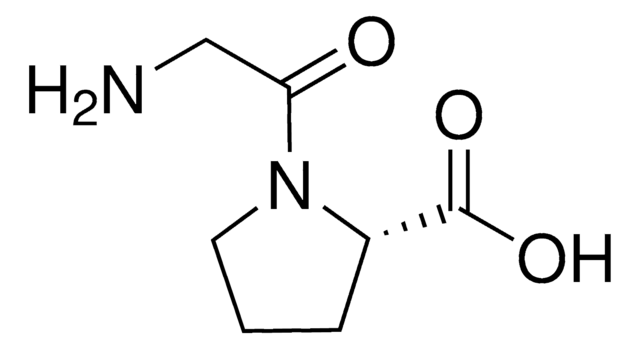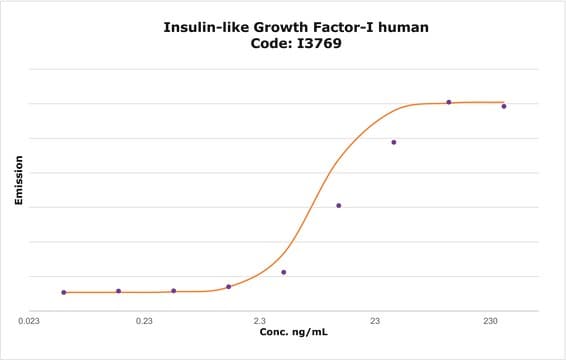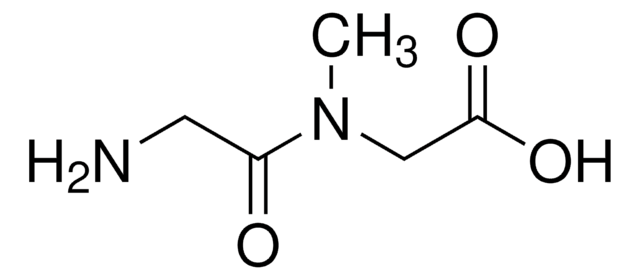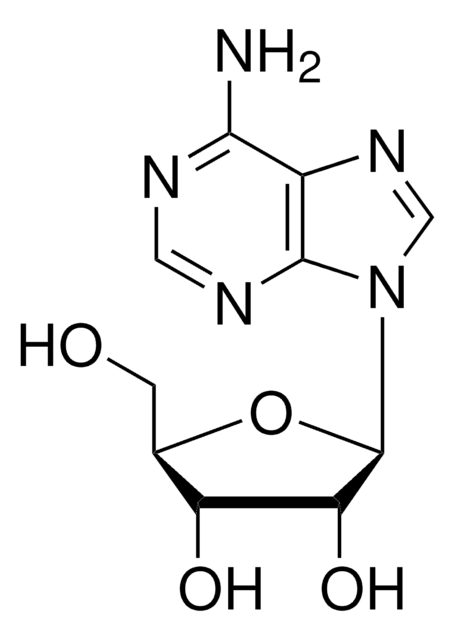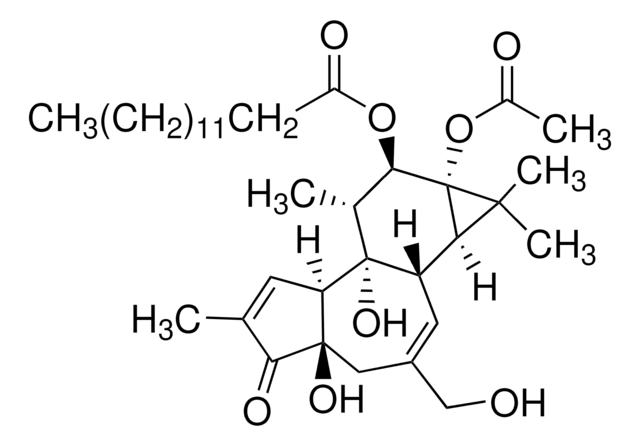모든 사진(1)
About This Item
실험식(Hill 표기법):
C12H19N3O6
CAS Number:
Molecular Weight:
301.30
MDL number:
UNSPSC 코드:
12352209
PubChem Substance ID:
NACRES:
NA.32
추천 제품
Quality Level
분석
≥98% (HPLC)
양식
powder
색상
white
저장 온도
−20°C
SMILES string
NCC(=O)N1CCC[C@H]1C(=O)N[C@@H](CCC(O)=O)C(O)=O
InChI
1S/C12H19N3O6/c13-6-9(16)15-5-1-2-8(15)11(19)14-7(12(20)21)3-4-10(17)18/h7-8H,1-6,13H2,(H,14,19)(H,17,18)(H,20,21)/t7-,8-/m0/s1
InChI key
JJGBXTYGTKWGAT-YUMQZZPRSA-N
일반 설명
IGF1 (insulin-like growth factor 1) protein is cleaved into des-N-(1-3)-IGF-1 and an N-terminal Gly-Pro-Glu (GPE tripeptide). It is thought to be an outcome of specific neural processing.
생화학적/생리학적 작용
Gly-Pro-Glu (GPE) is a neuroactive peptide and prevents the binding of glutamate to N-methyl-D-aspartate (NMDA) receptor. It positively regulates the potassium-mediated release of acetylcholine from rat cortical slices. Thus, it is involved in the control of brain function. In vitro studies show that this peptide confers neuroprotection to CA1-2 hippocampal neurons against excitotoxic insult.
Gly-Pro-Glu is a neuroprotective compound and the N-terminal tripeptide of IGF-1. Gly-Pro-Glu is neuroprotective after central administration in animal models of neurodegenerative processes, such as Huntington′s, Parkinson′s, Alzheimer′s diseases, and varies acute brain injury animal models. The neuroprotective activity is not related to its affinity to glutamate receptor. Findings indicate that GPE mimics insulin-like growth factor I effects on the somatostatin system through a mechanism independent of β-amyloid clearance that involves modulation of calcium and glycogen synthase kinase 3β signaling.
Storage Class Code
11 - Combustible Solids
WGK
WGK 3
Flash Point (°F)
Not applicable
Flash Point (°C)
Not applicable
가장 최신 버전 중 하나를 선택하세요:
T Alexi et al.
Experimental neurology, 159(1), 84-97 (1999-09-16)
Huntington's disease is an incurable genetic neurological disorder characterized by the relatively selective degeneration of the striatum. Lesioning of the striatum in rodents using the excitatory amino acid agonist, quinolinic acid (QA), effectively mimics the human neuropathology seen in Huntington's
J Saura et al.
Neuroreport, 10(1), 161-164 (1999-03-27)
Insulin-like growth factor 1 (IGF-1) plays a critical role in CNS development. IGF-1 can block neuronal apoptosis in vitro and in vivo. IGF-1 is thought to be cleaved into des-N-(1-3)-IGF-1 and an amino terminal glycine-proline-glutamate (GPE tripeptide). Here we report
Chih-Wei Chang et al.
European journal of drug metabolism and pharmacokinetics, 42(2), 239-249 (2016-04-28)
Resveratrol (3,4',5-trihydroxy-trans-stilbene; RES) produces a variety of pharmacological effects; however, its oral bioavailability (BA) approaches zero. In this study, grape peel extract (GPE) was incorporated into a solid dispersion delivery system to improve the solubility, dissolution and oral absorption of
Maxwell Mewa-Ngongang et al.
Foods (Basel, Switzerland), 8(2) (2019-02-06)
Microbial spoilage causes food losses in the food industry and as such, the use of synthetic chemical preservatives is still required. The current study proposes the use of agro-waste, i.e., grape pomace extracts (GPE), as production medium for biopreservation compounds.
Max Jakobsson et al.
BMC musculoskeletal disorders, 20(1), 137-137 (2019-04-01)
Physical capacity tasks are useful tools to assess functioning in patients with low back pain (LBP), but evidence is scarce regarding the responsiveness (ability to detect change over time) and minimal important change (MIC). The aim was to investigate the
자사의 과학자팀은 생명 과학, 재료 과학, 화학 합성, 크로마토그래피, 분석 및 기타 많은 영역을 포함한 모든 과학 분야에 경험이 있습니다..
고객지원팀으로 연락바랍니다.
